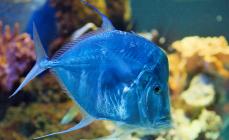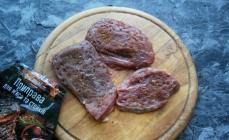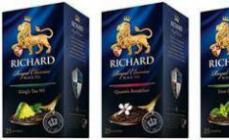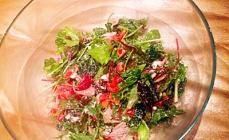Lamber is a beautiful, traditional cheese taste. It is made from the selected milk of the Altai Territory, the fatness of 55%. Cheese has a pleasant light yellow color, and throughout the mass contains uniformly located holes.
The taste of lamb cheese, very gentle, creamy, moderately salty. The consistency of the cheese is not very dense, but at the same time not soft.
The laber cheese formulation was developed by European cheesemores, based on the recipes tested by the recipes of Altai cheesecakes. Modern lamb cheese is performed under automated production conditions under constant control of specialists.
In the line of cheese Lambert three varieties:
Lambert "Classic" 50% fat
Lambert "creamy" 55% fat
Lambert "Tilziter" 45% fat.
Lamber cheese is perfect as self-dishesAnd as a component of many recipes. Melted lamb on pizza, and as a crust to baked potatoes, it's just magical taste.
For several years I have been buying this cheese from Wimm-Bill-Dann. The lamb is sold by a grace of 1 kg mass, or packaged by plates in vacuum packaging. Of the three types of cheese in my family, the "Classic" laber is most like. Cream cheese It seems too fat, and Tilziter, an amateur.
In the composition of the cheese, of course, there are a variety of preservatives, dyes, and many other not quite useful chemical additives. Such is our life, that all that is tasty is not entirely safe. I think, if you can easily use one or another product, there will be no harm.
When guests come, cheese slicing Lamber, flies instantly. In the cutting cheese, it is especially good, it will not crumble, pieces are smooth and neat.
ATTENTION TO ALL WEIGHTARIANS! Lamber cheese contains a rennet enzyme, absolutely non-vegetarian product. Be careful if the ethicity of the product comes first for you.
I completely trust Wimm-Bill-Dann and I will gladly buy their products, including Lambert Cheese. I have never come across a good quality product. Cheese is always tasty, fresh and fragrant. My little son with great pleasure eats the labe cheese classic. Sometimes, to improve the appetite, I rub the cheese on potatoes, pasta, and even dumplings. My dog \u200b\u200bregularly gets small pieces of cheese as promotion, and she is just delighted with his taste!
Although I sometimes experiment with other cheeses, but always return to the loved cheese of Lambera!
Video Overview
| All (3) |
|---|
Rumors about numerous fakes were greatly exaggerated
Cheese epic in Russia continues not the first month. We did not have time to ignore the Italian "parmesan's stormy sanctions sea untimely, as a new trouble was killed. Not so long ago, Rosselkhoznadzor stated that most of the domestic cheese, which appeared lately on store shelves ,.
What happens, is it better to forget about cheese? Or officials fly away? Are domestic cheeses from imported, and if so, what? And do not exaggerate control bodies, and together with them and the mass scale of the tragedy? To find out this, "MK" decided to pass several types of cheese in the laboratory.
For 300 rubles, do not wait good
For research, I bought two samples of the cheese of the domestic and imported manufacturer. The first popular variety of Lamber, the semi-solid cheese, was packed under vacuum into a polymer film. The pack is indicated by the manufacturer, located in the state farm. Lenin of the Moscow region. Date of development - July 15 of this year, packaging date - October 21 and shelf life - until January 13, 2016. The mass fraction of fat in the dry matter of the cheese was 50%. The price per kilogram is about 700 rubles. The second type of cheese is solid, "Parmesan", - I already bought for a swim. The cost is almost two times higher - 1300 rubles per 1 kg. According to the label that the store itself was stuck to packaged products, my cheese was brought from Argentina. In addition, the date of the product packaging was indicated - October 28 and the shelf life - 12 hours. But, as we understand, the date of manufacture and packaging is different things. Therefore, the exact date of the production of cheese remained unknown. The mass fraction of fat in Parmesan amounted to 43%.
Cheeses I passed on research to the laboratory, where they checked their fatty acid composition. According to test protocols, and in the other sample, the content of saturated and unsaturated acids does not exceed the norm. In particular, the palmitic acid content in Lambere is 28.7%. The norm for this type of cheese is from 22 to 33%. In the Argentine "Parmesan" the content of this acid is slightly lower - 28% with the same standards. "How so," the reader is surprised, "because in the cheese there should not be plant traces at all?". In fact of the matter! Palmitic, like other types of acids, in cheese can and should be present. And this does not mean that our favorite delicacy "infected" palm oil. Now if the palmitic acid content exceeds the norm, this is a reason to beat the alarm. But not in the case of our expertise.
How to distinguish cheese that contains vegetable fats, on which they are missing? Visually do it almost impossible. The only advice that specialists give, carefully read information on the packaging and choose a more expensive product.
- First of all, the name "Cheese" should be written on the packaging. If there is an inscription "Cheese product", it means that vegetable fats may be present in it, "says an expert on certification of milk and dairy products Olga Andreeva. - You should also explore the composition. Usually in the composition of the cheese milk normalized, starters, salt and milk-removal drugs. If vegetable fats were used during production, the manufacturer must indicate this in a good way.
Focus on the shelf life, alas, not worth it. We will remind, in April, we handed over three samples of cottage cheese to study, and vegetable fats were found in one of them. So here the cheese is shelf life in principle quite large, especially in solid cheeses with high heating temperature. Therefore, this indicator in this case is not a priority quality indicator. At the same time, according to Olga Georgievna, buyers should pay attention to where a dairy product is in the stores.
- Sometimes during stocks in supermarkets, they love to put the cheese heads right in the middle of the hall. It is wrong, such cheese is better not to take, "she explained. - Cheese should be stored at a temperature of +2 to +8 degrees, which ensures its safety and eliminates the formation of mold.
But what is really worth paying attention is the price. Cost good cheeseAccording to experts, there can be no less than 600-700 rubles per kilogram.
- To get 1 kilogram of cheese, I need to use 10 liters of milk. One litre whole milk From under the cow worth a minimum of 30 rubles. It already works 300 rubles, "says the farmer from the Moscow region Ilya Kutarin. - Plus you need to buy a starter, the renewed enzyme, will be the cost of work. So if in the store you see cheese for 300 rubles per 1 kg, most likely there are palm oil or some vegetable fats.
Now because of the sanctions, rare cheese from the West will reach. Most often on the shelves of the metropolitan stores, you can see huge heads from Argentina and Switzerland. In abundance shows cheese from.
According to Andreyeva, earlier to them in the laboratory were brought to the study of cheese from different countries - ,. And they all very well have proven themselves - no sample was rejected by fatty-acid composition. Also pretty good quality and Belarusian cheese. In the same cheese, as such do not produce. Metropolitan enterprises only buy raw materials and fault. The reason for this is simple: it is in Moscow there are no farms, so it's just nowhere to produce milk.
Another question that is now tormented by many: what cheese to take large companies or, on the contrary, smaller, positioning their products as farmers?
According to Andreyeva, it is better to still take products from large manufacturers. This applies not only to cheese, but also all the milk: cottage cheese, milk and so on. So you insight yourself from unexpected consequences.
The other day, for example, in the Office of the Moscow region, a message was held that in Ramensky, Stupinsky, Lyubertsy and Noginsky districts, cases of brucellize goats and sheep were registered in utility farms. Three cases of people infection have been revealed. Therefore, the population was recommended not to buy goat milk And cottage cheese in the farmers near Moscow.
Buy or not buy - a personal matter, of course, everyone. As, for example, Ilya Kutarin assures, their animals are absolutely healthy. And he himself, his wife and little child eating only their products. Therefore, in this case, you can advise only one thing: take these products from proven farmers that you know personally. Do not be lazy to go to the farm to go, live to see where they grow and what their goats, sheep and cows eat.
Most Salted - "Parmesan"
Cheese itself - the product is useful only in moderate quantities. It has a high cholesterol content - about 100 milligrams per 100 grams, so nutritionists recommend to use no more than 30 grams of cheese per day and no more than 3-4 times a week. Some cheers contain a daily salt rate, so with frequent eating, it is easily obtained by an excess of cholesterol and sodium in the body.
Nevertheless, cheese is not such a fat product, as it may seem.
- When selling on the package indicates the percentage of fatty in dry matter - 45-50%, but in fact in the cheese itself, taking into account water, 25-30%, which is significantly less. But, nevertheless, patients suffering from cardiovascular diseases, metabolic syndrome, obesity and overweight, it is recommended to use dietary types of cheese, where fat is less than 17%. 25-30% of fatty when weighing is a lot, "Natalia Pavlyuk explained to the nutritionist.
In addition, in the cheese there is a lot of protein, which is easily absorbed, as well as amino acids. For example, in some varieties contains histidine - acid that contributes to the strengthening of immunity, growth and restoration of tissues. At the same time, according to the nutritionist, histidine is involved in allergic reactions. Therefore, the allergies doctors do not recommend that there is a lot of cheese.
But the melted cheese and raw materials experts are generally advised not to buy. According to them, they make such cheese, in fact, from poor-quality raw materials - in particular, cheese, which approached the end of the shelf life. It has very little protein and a lot of cholesterol. Among melted cheese High and percent fakes.
So, the experiment "MK" is completed. What are the conclusions? Hysteria around palm oil The cheese is slightly exaggerated. In fact, the whole thing in price. The cheaper the product, the less qualitative. And this story is not only about cheese. Well, it is impossible for 300-400 rubles per kilogram to buy a good natural cheese. Therefore, if you want to eat right, suck money. No - take what's on the pocket. The only thing, after all, it is necessary that the manufacturer honestly pointed the ingredients in its product.
How to distinguish high-quality cheese from poor quality?
Pay attention to the taste of cheese and its color. The taste should not be bitter. From cheese should not smell ammonia - this smell occurs in the process of rotting. It is clear that each type of cheese has its own fragrance. For example, "Lamember" he has a slightly sourish, "Maasdam" is spicy and slightly sweet. But the main thing, it should be clean and enjoyable. The color of the cheese should be homogeneous, without spots. Nutritionists do not advise you to take cheese too bright orange, since in addition to beta-carotene there may also be a dye.
The holes in the cheese should be uniform. Closer to the crust their number decreases, but the size should be maintained. If they become smaller at the edges, it is not good. If the holes merge into the tracks, such cheese is also better not to take.
When cutting, the cheese should not crumble. If the cheese parser try to bend, it should not break. In addition, the cheese must be elastic, with adequate to it should not be dents, there should be no liquid discharge.
Unfair manufacturers in cheese can sometimes add starch - to increase the volume of the product. Check it easily - it's worth a drop of iodine on a piece. If he squints, then starch in the cheese is present. Also, solid cheese of good quality, according to the nutritionist, it is impossible to roll into the ball - he will still crumble.
How to cook cheese at home
Recipe from Cheeseer Ilya Kutarina
For the preparation of cheese at home you will need the following ingredients: 5 liters of milk (natural cow) and 1/4 tsp. Liquid rennet enzyme (dissolve in 50 ml of cold water).
Pour milk into the pan, bring to a temperature of 35 ° C. Add the rennet enzyme pre-dissolved in water, and mix well for 30 seconds. Cover the saucepan with a lid or a towel and leave for 30-40 minutes. Check the boost formation. Clean bunch of serum branch must be achieved. If this has not yet happened, leave for another a few minutes. Cut the clutch on the cubes with a side of 3 cm. Leave for 10 minutes to bunch donkey. Put the entire bunch in the colander. After 3 hours carefully turn the cheese and leave overnight.
Sattail Salt Cheese (not iodized). Cheese is ready!
For reference
Emmental cheese, 100 g
Contains 28 g of fat, 28 g of protein.
Contains an amino acid - tryptophan, which in the process of synthesis is converted to serotonin - hormone of happiness, as well as vitamin A, calcium, phosphorus, 50% daily norm Sodium (salt) - 700 mg.
Cheese "Cheddar", 100 g
Contains 23.5 g of protein, 31 g of fat.
Rich in tryptophan and histidine, a lot of vitamin A, group B, calcium, sodium.
Cheese "Creamy", 100 g
Rich in fats, but very little protein. Also, few amino acids, calcium and vitamins.
Russian cheese, 100 g
Contains 23 g of protein, 30 g fat.
Rich in vitamins A, B12, calcium, sodium, phosphorus, zinc.
Contains 88 mg of cholesterol.
Cheese "Adygei", 100 g
Contains 20 g of fat, 20 g of protein.
Many vitamins A, RR (neocin), calcium 52% of the daily rate, a lot of sodium (1/5 part of a teaspoon of salt), phosphorus. 54 mg of cholesterol.
Cheese "Mozarella", 100 g
Contains 22 g of fat, 22 g of protein.
It has a lot of tryptophan, vitamin A, group B, calcium, selenium.
79 mg of cholesterol.
Cheese "Gaud", 100 g
Contains 27 g of fat, 25 g of protein.
According to the amino acid composition, it is balanced, little vitamin A, but a lot of B12, calcium. Sodium twice as bigger than in adygei cheese.
114 mg of cholesterol.
Cheese "Parmesan", 100 g
Contains 26 g of fat, 36 g of protein.
The amino acid composition is balanced. There is vitamin A, a group B, RR, a lot of selenium and zinc. The leader in terms of calcium is 1184 mg, and sodium - 1602 mg is four times more than in Adygei cheese (a teaspoon of salt).
68 mg of cholesterol.
Cheese lamb. traditional cheese Vimm-Bill-Dann company represented him in the Russian Federation in 2003. It is made in the Altai Territory, hence the milk is supplied for its manufacture. After analyzing prices in stores on how much labe cheese costs, we obtain the following data:
- 1 kg semi-solid in a barrel: 740-801 ruble;
- 1 kg creamy in a barrel: 750-780 rubles;
- Packaging 430 grams semi-solid: 210-220 rubles.
To more accurately determine the issue, you will need to disassemble the following nuances:
- Views;
- Price in stores.

The main types of lamb cheese are:
- Standard. The resulting cheese, packed in a barrel in yellow packaging. Implemented by price 760 rubles per kg. Can also be packed in a small pack of 230 Gy, for which you have to give 212-220 rubles. Also, many shops are offered to cut the finished piece and implement at the price of 0.8 rubles / grams;
- Creamy 55%. This is a variety of lamber, characterized by the taste. It has a similar shape and fusing a barrel of 1 kg. The difference is only in the color of the label (here it is red). Price on the market 750-780 rubles. Can also be sold by 8 rubles For 10 grams for weight.
These data will make sure to understand the price on this cheese, when choosing a suitable view.
Cheese Cheese in stores

Due to the popularity of the Lamber cheese, it can be found in almost any store. Among these are allocated:
- Pyaterochka. Average price for product 780 rubles. This network is available in almost every area of \u200b\u200bany city;
- In a magnet. Implements in 760 rubles. As the first has shopping points throughout the country;
- In Auchan. Sells this cheese 750 R.. These shopping pavilions can be found only in large cities (for example in Moscow or St. Petersburg);
- Okay. Another brand of hypermarkets offering this product by 801 rubles;
- Tape. Offers PO 790 rublesdisseminated throughout the country.
Also today is developing online sales market, where this product is also being implemented. Large representatives of this market are:
- Platypus: 739 rubles;
- Okadovka: 801 rubles;
- Metro: 469 rubles;
These provisions will help to understand how much lamb cheese is if you visit one or another store.
Traditional lamb cheese, appeared on russian market In 2003, the cow milk of the Altai Territory is unique in terms of its qualities.
This cheese belongs to the semi-solid squeezed varieties of cheese. It has a light yellow color and unique pronounced creamy taste, aroma and very tender texture. For the raw mass, a large number of small eyes-holes are quite chaotic.
The manufacturer is the company. Wimm-Bill-Dann, Russia. Currently, this company belongs to the American company PepsiCo. It should be noted that the "Lambera" cheese production plant is located in the Altai Territory.
An important feature of "Lambon" is the original round form, the production patent of which PepsiCo has. Packing - 1.15 kg.
The calorieness of the lamb cheese is 377 kcal per 100 g of the product, the mass fraction of fat in the dry matter is 50%. There is such a kind of cheese as "creamy", with ppm 55%.

As part of a lamb cheese:
- pasteurized cow's milk
- bacterial concentrate of mesophilic and thermophilic bacteria Choozit.
- milk Screwing enzyme preparation of animal origin clerici
- salt cooking food
- natural E160B Food Dye
- conservative Nitrate Potassium
Useful properties of lamb cheese
Like any cheese, the lamb contains great amount Calcium, and therefore improves the condition of the teeth, hair, nails and bones.
There are no carbohydrates in the cheese, the fourth part accounts for the protein content, the rest belongs to the fat. This renewed cheese is very rich in phosphorus. It contains such vitamins as: vitamin A, E, vitamin D, RR, vitamin C, B1, B2, B12, as well as pantothenic acid.
Pantothenic acid, which is in the cheese of the laber, promotes the work of the immune system, improves the condition of muscle tissues, increases stress resistance, helps the work of adrenal glands, participates in fats and carbohydrate reactions.
And vitamin C has a powerful antioxidant effect, improves the strength of blood vessels, increases their elasticity, favorably affects the condition of the connective tissue, increases the susceptibility of the body to various diseases, promotes the early healing of wounds, as well as skin ulcers.
Thanks to the rich content of vitamins, the product helps the body to grow and develop, improves the brain and restores the forces after severe physical and mental loads.
Cheese Lambery in Cooking
Cheese Lambera, like all solid cheesesIt is widely used in cooking, combined with many dishes. It is in the composition
Semi-solid lamb cheese is made from natural milk in Altai. It is distinguished by a soft cream taste, a gentle texture and a pronounced fragrance. And his unusual trait is the original form of release, for which he was called "Barrel". Cheese is sold only entirely and tightly packed due to the natural nature of the composition. Store for a long time in the open air, the label cheese will not work, and it is eaten quickly, because very tasty.
Appearance
 Lambert cheese is released in the original round form. Pepsico has a patent for its use. The product is packaged in a special color food film: it protects cheese from excess moisture and exposure to ultraviolet rays, and also gives the consumer information about the product. The whole cheese head weighs 1 kilogram.
Lambert cheese is released in the original round form. Pepsico has a patent for its use. The product is packaged in a special color food film: it protects cheese from excess moisture and exposure to ultraviolet rays, and also gives the consumer information about the product. The whole cheese head weighs 1 kilogram.
Cheese has a light yellow color and a pronounced pleasant aroma. On the context of the product, a large number of eyes are noticeable - this suggests that its ripening passed under the influence of natural bacteria. It means that cheese is characterized by a good taste.
Production
The first trial cooking product took place on August 20, 2003, on an industrial scale, it began to be released in September of the same year. The labe cheese producer is a Rubtsovsky dairy plant located in the Altai Territory. In 2001, the owner of the production of dairy serum and other products was the company Wimm-Bill-Dann.
Late production capacity was oversold. Today, the brand, production and company belong to the American concern PepsiCo.
Structure

- Pasteurized cow's milk
- Bacterial concentrate of mesophilic and thermophilic bacteria Choozit
- Milk Screwing enzyme preparation of animal origin clerici
- Calcium chloride E509.
- Salt cooking food
- Natural E160B Food Dye
The main component of the composition is a natural normalized cow's milk. It is processed with the addition of a microbial origin of microbial origin and bacterial concentrate of thermophilic and mesophilic bacteria.
The composition has a mass of beneficial substances, for example - calcium, vitamin C, pantothenic acid.
The cheese head contains 3,650 calories. Per 100 grams of the product account for 365 calories. Lose weight with cheese will not work, but he perfectly quenched hunger.
Semi-solid cheese Laber is added to salads and second dishes, served as a snack. Connoisseurs of premium products combine it with wine. The taste of the product also harmonizes well with any other products and drinks. Cheese melts well, forming a stretching crust, so it is used in baking.
The main distinguishing features of the semi-solid cheese of the lamb is mild, but a pronounced creamy taste and natural composition. Today, Laber is a great combination of high quality and pleasant taste.
Beneficial features:
- improves the condition of nails, hair, teeth;
- increases the elasticity of tissues;
- has an antioxidant effect;
- improves the work of the immune system.
Cheese Lambera: Packing and price
Order "Cheese Lambera semi-solid barrel" in the hypermarkets of Moscow






